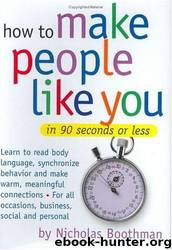How to Make People Like You in 90 Seconds or Less by Nicholas Boothman

Author:Nicholas Boothman
Language: eng
Format: mobi, epub
Tags: Language Arts & Disciplines, Personal Growth - General, Psychology, Family & Relationships, Communication, Communication Studies, General, Interpersonal communication, Interpersonal Relations, Self-help & personal development, Self-Help, Personal Growth, Communicative competence, Self Improvement: General, Personality
ISBN: 9780761119401
Publisher: Workman Publishing
Published: 2000-08-18T17:11:56.556000+00:00
How to Make People Like You In 90 Seconds Or Less
In and Out of Sync
For this exercise, you will need two other people: A and B. A is the first to do the actions; B synchronizes with A's actions. You start off as the director.
Sitting, standing or walking, A and B converse casually about anything they want. A makes a point of moving about enough to give B some body movements and gestures to synchronize. After about a minute, tell them to break synchrony. At this point, B deliberately mismatches A's movements. After another minute or so, instruct B to get into sync again. Then, after another minute, get them to break once more. Finally, have them get back in sync before finishing.
Now switch places with A or B. Keep rotating so that each one of you assumes a different role in the exercise. Compare notes at the end of each rotation. The comments will most likely be similar to these: “When I broke synchronization, it was as if a huge wall had been erected between us” and “When we stopped synchronizing, the level of trust plummeted.”
You can also try this out on your own. Synchronize someone for a couple of minutes, then deliberately mismatch his or her movements for one minute before getting back -*
into synchrony again. Go in and out at will and notice the difference; it will be tangible.
Leading When you're sitting and talking with a friend, one of you might cross a leg and the other might do the same without thinking. This means that one of you is following the other's lead, which is a sure sign that the two of you are in rapport.
As you quickly become proficient at synchronizing, you can test to find out just how well your rapport is going. After three or four minutes, regardless of what has gone before and without the other person being aware of what you're doing, make a subtle move that's independent of your synchronizinglean back or cross your arms and perhaps tilt your head. If the other person follows, then you are synchronized and have rapport and the other person is now subconsciously following your lead. If you tilt your head, she tilts hers. If you cross your legs, he crosses his. Just change what you're doingmake a movement, alter your vocal toneand observe whether the other person matches or mirrors you. This way you can check to see if you are in rapport. If the other person doesn't follow your lead, go back to synchronizing his or her movements for a few minutes and try again until it works.
I teach volunteers who sit with cancer patients how to have rapport with those in their care. This is the first thing I stress. Breathe in and out with them. Then, when you speak, you're doing it on their “out” breath, and this has a very calming effect.
Rhythms. The same rule applies for anything rhythmic. If she taps her foot, tap your pencil; if he nods his head, pat your thigh.
Download
How to Make People Like You in 90 Seconds or Less by Nicholas Boothman.epub
This site does not store any files on its server. We only index and link to content provided by other sites. Please contact the content providers to delete copyright contents if any and email us, we'll remove relevant links or contents immediately.
| Codependency | Conflict Management |
| Dating | Divorce |
| Friendship | Interpersonal Relations |
| Love & Loss | Love & Romance |
| Marriage | Mate Seeking |
Doing It: Let's Talk About Sex... by Hannah Witton(8565)
The 5 Love Languages: The Secret to Love That Lasts by Gary Chapman(8532)
Should I Stay or Should I Go? by Ramani Durvasula(6802)
The Road Less Traveled by M. Scott Peck(6650)
The Lost Art of Listening by Michael P. Nichols(6485)
Daring Greatly by Brene Brown(5652)
We Need to Talk by Celeste Headlee(4882)
Beartown by Fredrik Backman(4437)
Men In Love by Nancy Friday(4342)
The State of Affairs by Esther Perel(3946)
The Rules Do Not Apply by Ariel Levy(3915)
How To Win Friends and Influence People by Dale Carnegie(3784)
Reflections Of A Man by Mr. Amari Soul(3710)
The Ethical Slut by Janet W. Hardy(3513)
Algedonic by r.h. Sin(3510)
Pillow Thoughts by Courtney Peppernell(3420)
Finding My Forever by Heidi McLaughlin(3315)
He's Just Not That Into You by Greg Behrendt & Liz Tuccillo(3312)
I Love You But I Don't Trust You by Mira Kirshenbaum(3236)
